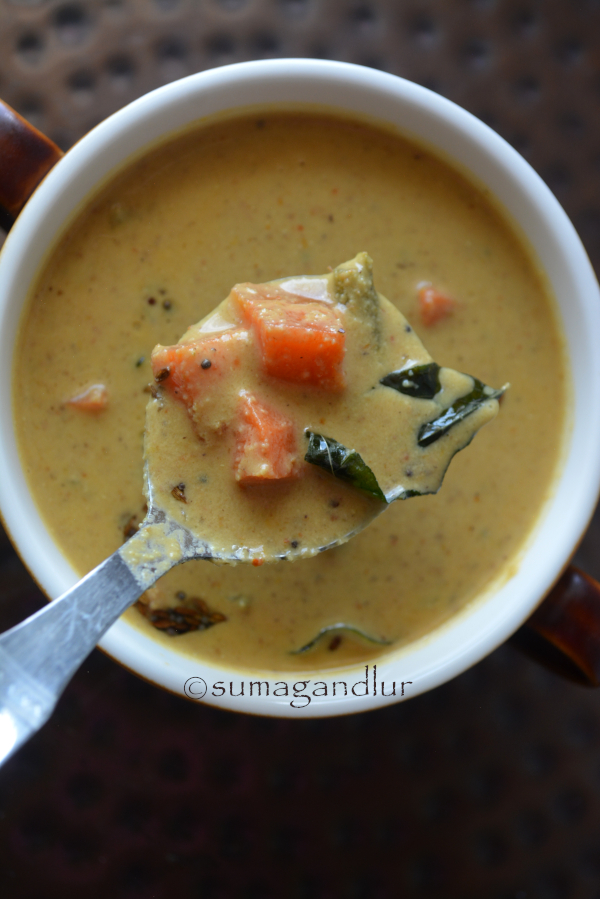This recipe had been on my to do list since I noticed it at Pavani's space and am glad that I decided to try it. It was so good that even my coconut hating husband loved it and my mother who watched it over our video chaat found it very appetizing just by the looks of it.
It is not the kind of sambhar where a handful of peanuts are thrown in but is an interesting variation with a peanut base. This delicious sambhar doesn't use any lentils or any kind of beans and makes a flavorful and spicy side dish. The original recipe had sauteed onion, tomato and garlic which I omitted and added some vegetables. One can choose to go either way or one can add vegetables on hand. I also reduced the cumin seeds' quantity and added a little sweetener.

Ingredients:
For the paste:
1/4 cup peanuts
1 tbsp. coriander seeds
1/2 tsp. cumin seeds
1/8 tsp. fenugreek seeds
3 dried red chillies
1/4 cup dry coconut, grated
For tempering:
1 tsp. oil
1/2 tsp. mustard seeds
1/2 tsp. cumin seeds
A sprig of curry leaves
A pinch of asafoetida powder
For sambhar:
1 cup chopped, mixed vegetables *
1/8 tsp. turmeric powder
Salt to taste
1 tbsp. thick tamarind puree or to taste
1/4 tsp. jaggery / sugar (optional)
* I used peeled and diced carrots and chopped beans. The original recipe had sauteed onion and tomato instead.
Directions:
* Cook the vegetables adding enough water in a microwave, pressure cooker or in a pan on stove top. Keep them aside.
* Dry roast peanuts on low flame, continuously stirring for 3 - 4 minutes. Add coriander seeds, cumin seeds, fenugreek seeds and red chillies next and toast until fragrant and the seeds start to change a shade darker. Add coconut and stir once. Turn off the stove and let the ingredients cool. Grind the ingredients to a smooth paste adding enough water.

* Heat oil in a pan and add mustard seeds, and cumin seeds. When mustard seeds start to splutter, add curry leaves, turmeric, asafoetida and stir. Immediately add the cooked vegetables along with water used to cook them, the peanut paste, salt, tamarind and sweetener if using. Add water to reach the desired consistency like a sambhar / stew. Taste and adjust the seasonings if needed. Simmer the sambhar for 7 to 8 minutes and serve hot with rice.
Comments
It is not the kind of sambhar where a handful of peanuts are thrown in but is an interesting variation with a peanut base. This delicious sambhar doesn't use any lentils or any kind of beans and makes a flavorful and spicy side dish. The original recipe had sauteed onion, tomato and garlic which I omitted and added some vegetables. One can choose to go either way or one can add vegetables on hand. I also reduced the cumin seeds' quantity and added a little sweetener.

Ingredients:
For the paste:
1/4 cup peanuts
1 tbsp. coriander seeds
1/2 tsp. cumin seeds
1/8 tsp. fenugreek seeds
3 dried red chillies
1/4 cup dry coconut, grated
For tempering:
1 tsp. oil
1/2 tsp. mustard seeds
1/2 tsp. cumin seeds
A sprig of curry leaves
A pinch of asafoetida powder
For sambhar:
1 cup chopped, mixed vegetables *
1/8 tsp. turmeric powder
Salt to taste
1 tbsp. thick tamarind puree or to taste
1/4 tsp. jaggery / sugar (optional)
* I used peeled and diced carrots and chopped beans. The original recipe had sauteed onion and tomato instead.
Directions:
* Cook the vegetables adding enough water in a microwave, pressure cooker or in a pan on stove top. Keep them aside.
* Dry roast peanuts on low flame, continuously stirring for 3 - 4 minutes. Add coriander seeds, cumin seeds, fenugreek seeds and red chillies next and toast until fragrant and the seeds start to change a shade darker. Add coconut and stir once. Turn off the stove and let the ingredients cool. Grind the ingredients to a smooth paste adding enough water.

* Heat oil in a pan and add mustard seeds, and cumin seeds. When mustard seeds start to splutter, add curry leaves, turmeric, asafoetida and stir. Immediately add the cooked vegetables along with water used to cook them, the peanut paste, salt, tamarind and sweetener if using. Add water to reach the desired consistency like a sambhar / stew. Taste and adjust the seasonings if needed. Simmer the sambhar for 7 to 8 minutes and serve hot with rice.

























